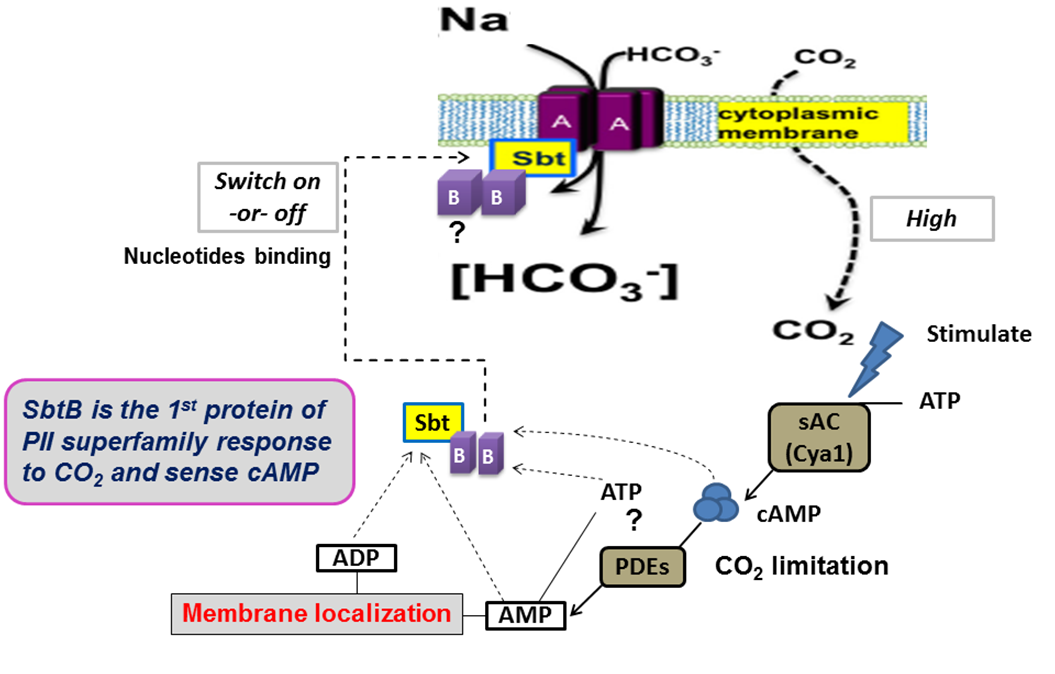3. DFG-supported project in the priority program SPP 1879 – Nucleotide Second Messenger Signaling in Bacteria
Subproject: Linking second messenger nucleotide signaling with CO2 homeostasis in cyanobacteria: unravelling the SbtB-based network. (HA 2002/24-1, joint project together with Prof. Karl Forchhammer, University of Tübingen, project period 2019-2022)
Cyanobacteria are oxygenic phototrophs able to assimilate CO2 into organic compounds. However, the CO2 levels in aquatic habitats are often limiting and may rapidly change. Therefore, cyanobacteria need sophisticated systems to acclimate to fluctuating CO2 availability to sustain CO2 fixation. To be able to fix CO2 at low ambient concentrations, cyanobacteria evolved an efficient carbon concentrating mechanism (CCM) that enables high affinity inorganic carbon uptake. At the level of gene expression, the CCM is mainly regulated by two LysR-type transcriptional factors that use metabolic signals as corepressors or coactivators. However, mutation of these transcription factors only partly abolishes the acclimation toward changing CO2 conditions, implying that additional regulatory and sensory mechanisms are necessary to achieve CO2 homeostasis in cyanobacterial cells. Recently, we identified the protein SbtB as potential CO2-sensing module. SbtB shows considerable structural similarity to PII-proteins, which play an important role in the sensing of the metabolic carbon/nitrogen balance in prokaryotes and plants. Similar to PII proteins, SbtB is able to bind adenine nucleotides. However, unlike PII proteins, SbtB binds the second messenger cAMP with even higher affinity. An SbtB-deficient mutant is severely impaired in the acclimation to varying CO2 levels. The activity of the major cAMP-synthesizing enzyme, the soluble adenylate cyclase, is long-known to be modulated by bicarbonate levels in different cells including cyanobacteria, however, the physiological relevance was enigmatic. Therefore, we concluded that the SbtB protein represents a new PII-like sensory molecule that senses changes in inorganic carbon availability depending on the second messenger cAMP among cyanobacteria. In this respect, the role of cAMP is reminiscent to the well-known roles of cAMP in many organisms for regulating sugar metabolism. Recently, we also found that sbtB mutation has marked impact on the expression of specific subset of CO2-regulated genes and that SbtB can not only bind cAMP but also cyclic-di-AMP. The aim of this proposal is to unravel the second messenger signaling network around SbtB in the model cyanobacterium Synechocystis sp. PCC 6803. For this purpose, we will determine how the cAMP-related SbtB signaling is integrated into the cellular network of CO2 acclimation. Furthermore, the function of the newly identified SbtB ligand c-di-AMP will be analyzed. To understand the signal transduction network organized by SbtB, we aim to identify interaction targets of SbtB and to find out, how these interactions are modulated by nucleotide second messenger molecules. In addition, SbtB exhibits a redox-responsive C-terminus and we aim to identify the link between second messenger signaling and the presumed redox control via this C-terminal segment of SbtB.








